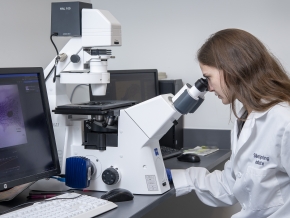Predicting Chemical Hazards

We know exposure to toxic chemicals can play an important role in the development of breast cancer. We also know women are exposed to many harmful chemicals including chemical mixtures in their daily lives through consumer products, drinking water, industrial chemicals, and pesticides.
Hight throughput screening approaches—traditionally used in drug discovery—have emerged as an important tool in toxicology for rapidly testing large numbers of chemicals for their potential to cause harm. Silent Spring scientists are working to expand the power of these tools to identify chemicals that might increase breast cancer risk, as well as impact breast feeding and timing of puberty.
There are different ways chemicals can trigger or hasten the development of breast tumors. Chemicals can damage DNA, cause cells to make more estrogen or progesterone, or alter genes involved in breast development. Identifying the changes that take place in cells when exposed to a breast carcinogen can help regulatory agencies and manufacturers know what to look for when testing chemicals for safety, ultimately to keep breast carcinogens from being used in products or released into the environment in the first place.
Thinking more upstream, Silent Spring is also developing new computational approaches using artificial intelligence to predict the toxicity of chemicals and chemical mixtures based on their molecular structures. This would allow scientists to quickly scan thousands of chemicals and flag those with the same structural features as chemicals we know are linked with breast cancer. For instance, there are chemicals called endocrine disruptors (EDCs) that can increase levels of estrogen and progesterone and affect the breast. By analyzing the molecular structures of EDCs, we can see the features they have in common and use them in order to identify other potential EDCs, ultimately helping scientists prioritize chemicals for further testing.
Funded by
News & Updates
2024
Hundreds of chemicals that influence the development of breast cancer are used in everyday plastic items, according to new study by Silent Spring.
2024
In a comment submitted to the U.S. Environmental Protection Agency (EPA), scientists at Silent Spring Institute say the agency’s pesticide safety reviews overlook pesticides that could increase breast cancer risk.
2024
Silent Spring scientists advance understanding of how endocrine disrupting chemicals influence breast cancer risk.
2022
Scientists call on regulators to update their methods for screening chemicals that could harm the breast.